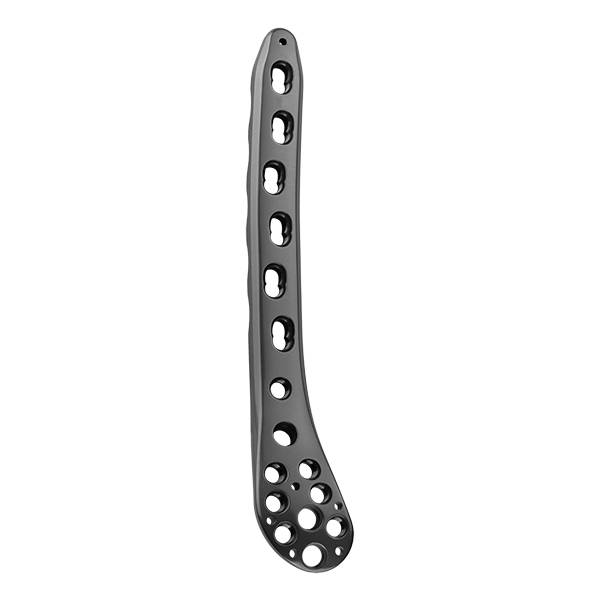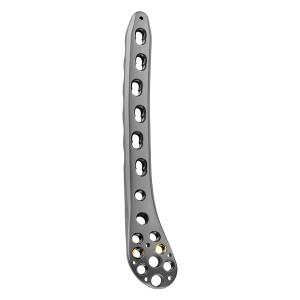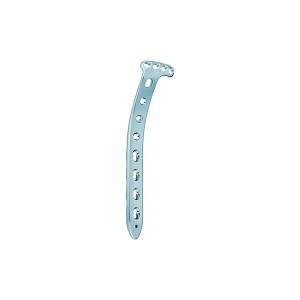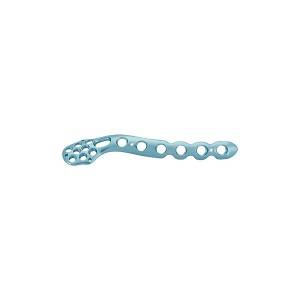Multi-axial Distal Femur Locking Plate
Features:
1. Multi-axial ring design for proximal part can be adjustment the angel to meet the clinic demand;
2. Titanium material and advanced processing technology;
3. Low profile design helps reduce soft tissue irritation;
4. Surface anodized;
5. Anatomical shape design;
6. Combi-hole can be choosing both locking screw and cortex screw;

Indication:
Orthopedic implants for multi-axial distal femur locking plate is suitable for distal femur fracture.
Used for Φ5.0 locking screw, Φ4.5 cortex screw, Φ6.5 cancellous screw, matched with 5.0 series orthopedic instrument set.
Multi-axial Distal Femur Locking Plate Specification
|
Order code |
Specification |
|
|
10.14.27.05102000 |
Left 5 Holes |
153mm |
|
10.14.27.05202000 |
Right 5 Holes |
153mm |
|
*10.14.27.07102000 |
Left 7 Holes |
189mm |
|
10.14.27.07202000 |
Right 7 Holes |
189mm |
|
10.14.27.09102000 |
Left 9 Holes |
225mm |
|
10.14.27.09202000 |
Right 9 Holes |
225mm |
|
10.14.27.11102000 |
Left 11 Holes |
261mm |
|
10.14.27.11202000 |
Right 11 Holes |
261mm |
Distal Femur Locking Plate
Features:
1. Titanium material and advanced processing technology;
2. Low profile design helps reduce soft tissue irritation;
3. Surface anodized;
4. Anatomical shape design;
5. Combi-hole can be choosing both locking screw and cortex screw;

Indication:
Medical implants for distal femur locking plate is suitable for distal femur fracture.
Used for Φ5.0 locking screw, Φ4.5 cortex screw, Φ6.5 cancellous screw, matched with 5.0 series medical instrument set.
Distal Femur Locking Plate Specification
|
Order code |
Specification |
|
|
10.14.26.05102400 |
Left 5 Holes |
153mm |
|
10.14.26.05202400 |
Right 5 Holes |
153mm |
|
*10.14.26.07102400 |
Left 7 Holes |
189mm |
|
10.14.26.07202400 |
Right 7 Holes |
189mm |
|
10.14.26.09102400 |
Left 9 Holes |
225mm |
|
10.14.26.09202400 |
Right 9 Holes |
225mm |
|
10.14.26.11102400 |
Left 11 Holes |
261mm |
|
10.14.26.11202400 |
Right 11 Holes |
261mm |
Titanium bone plates as orthopedic implants. Are provided for medical institutions, and are intended to treat the fracture sites of patients under general anesthesia by trained or experienced doctors in the operation room complying with environmental requirements.
Locking plate and screw systems have advantages over the conventional screw systems. Without this intimate contact, tightening of the screws will draw the bone segments toward the plate, resulting in alterations in the position of the osseous segments and the occlusal relationship. Conventional plate/screw systems require precise adaptation of the plate to the underlying bone. Locking plate/screw systems offer certain advantages over other plates in this regard. The most significant advantage may be that it becomes unnecessary for the plate to intimately contact the underlying bone in all areas. As the screws are tightened, they "lock" to the plat e, thus stabilizing the segments without the need to compress the bone to the plate. This makes it impossible for the screw insertion to alter the reduction.
The locking bone plate is manufactured by pure titanium, intended to be used for reconstruction and internal fixation of Clavicle, limbs and irregular bone fractures or bone defects. The product is provided in non- sterilized packaging and intended for single use only.
The combination holes consisting of threaded holes and compression holes on the locking plate can be used for locking and compression, which is convenient for the doctor to choose. The limited contact between bone plate and bone reduces the destruction of periosteal blood supply.The locking plate/screw systems is that they do not disrupt the underlying cortical bone perfusion as much as conventional plates, which compress the undersurface of the plate to the cortical bone.
Locking plate/screw systems have been shown to provide more stable fixation than conventional nonlocking plate/screw systems.
Use of locking plate/screw systems is that the screws are unlikely to loosen from the plate. This means that even if a screw is inserted into a fracture gap, loosening of the screw will not occur. Similarly, if a bone graft is screwed to the plate, a locking screw will not loosen during the phase of graft incorporation and healing. The possible advantage to this property of a locking plate/screw system is a decreased incidence of inflammatory complications from loosening of the hardware. It is known that loose hardware propagates an inflammatory response and promotes infection. For the hardware or a locking plate/screw system to loosen, loosening of a screw from the plate or loosening of all of the screws from their bony insertions would have to occur.








